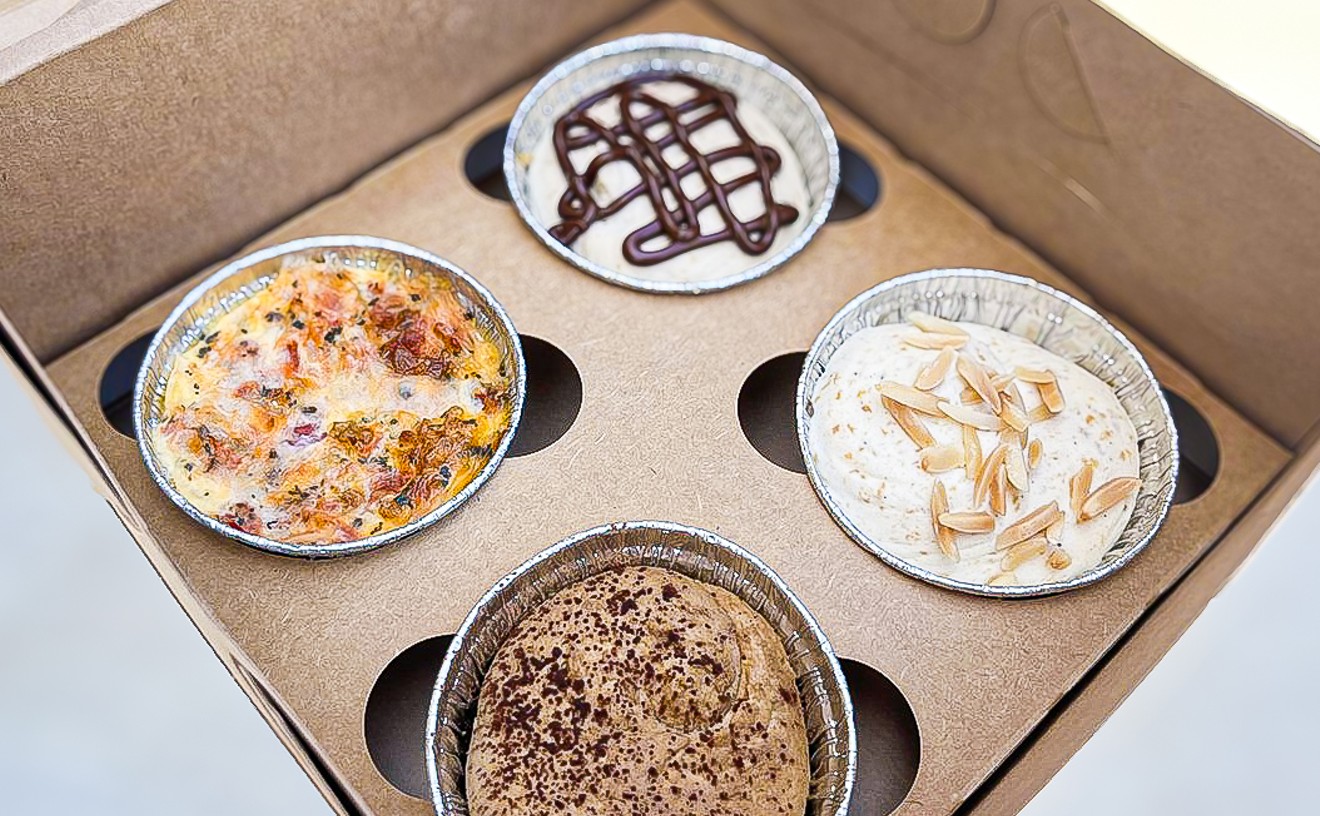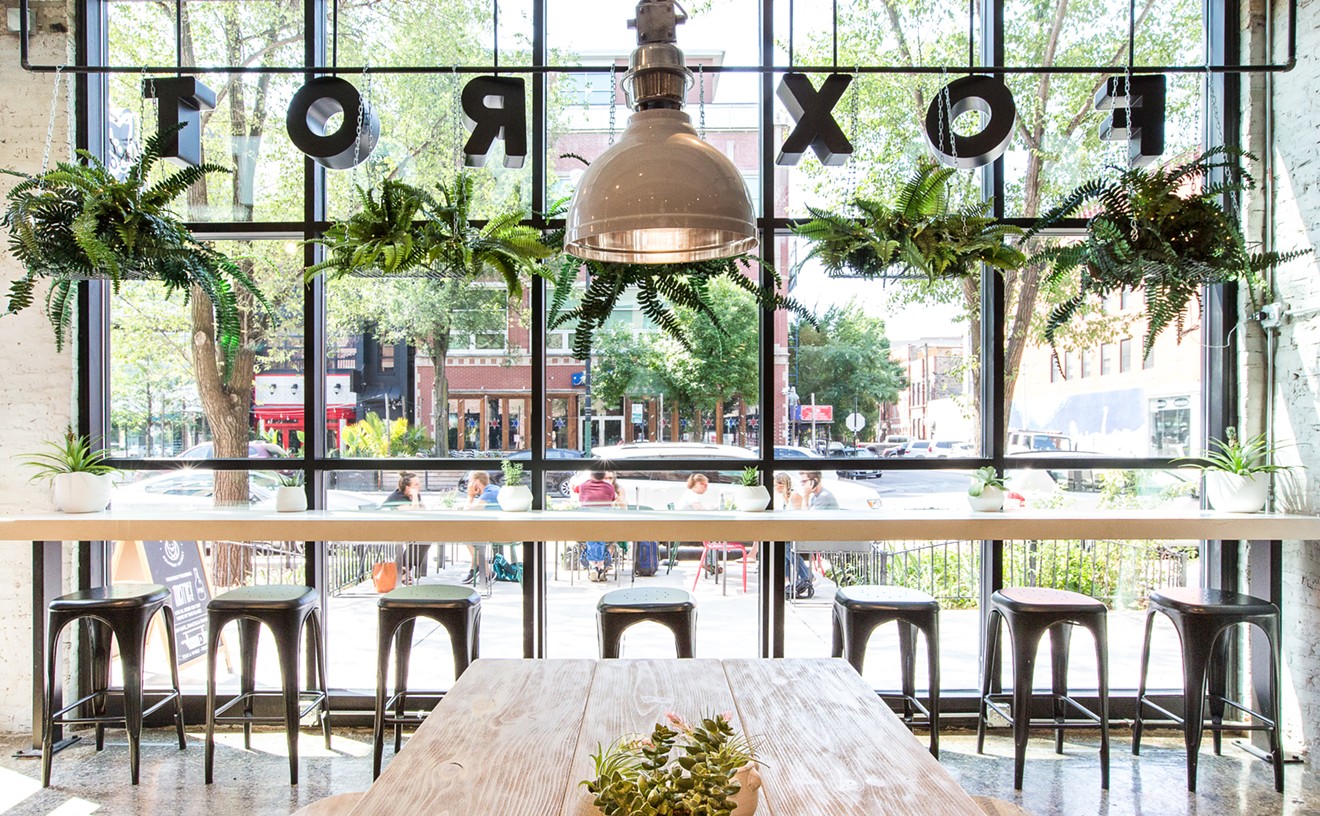Longtime Dallas chef Kent Rathbun says he and partner Robert Hoffman, a former Coca-Cola distributor, ruminated over and ran trademark searches on a long list of names before arriving at two choices: Abacus and Onyx. Rathbun was partial to the latter, Hoffman the former. The tiebreaker came after Hoffman had dinner in California with one of his favorite artists, Jasper Johns. "So Robert comes back and says, 'Jasper Johns likes Abacus,'" Rathbun says. "That's as simple as it was.
"And it seems to have been a good choice. I mean, I haven't had anybody come in here looking for Chinese duck for five dollars."
Question two: Why is the food so dizzyingly complicated and pricey that it would make that five-dollar Chinese duck pass out? Rathbun denies his menu is expensive. But he doesn't dispute the high volume of flavors and elements interacting on his plates. Take one entrée: grilled beef Rossini with seared foie gras and Madeira herb glaze ($29). Sounds not much different from a simple Rossini. It arrives like a double-stacked ice-cream sandwich, or maybe a beehive hairdo before a good bluing. A brioche mattress girds a small, thick, ruddy tenderloin disk that's topped by a baby portobello mushroom and a piece of seared foie gras. The flavors are voluptuous. But why the brioche? It didn't seem to add anything, and it sort of got in the way, making the thing topple over every time it was cut.
During a discussion before his McKinney restaurant opened, Rathbun said the menu would be adventurous, but below the cost of most upscale restaurants in town. Sort of middle upscale, or upper mid-scale.
Here's his thinking: The menu is divided into two sections -- small plates, essentially a list of appetizers ranging from $7 to $20; and big plates, entrées ranging from $24 to $34. Rathbun sees this structure as offering diners an economical option for dining at an upscale restaurant. "You can come in here and spend some money," he says. "But there are a lot of people who leave here with a couple of appetizers under their belts and they're thrilled."
I suppose. But I tried a pair of those small plates, and I was less than thrilled with the price-to-belt-stressing ratio. Garlic roast lobster in golden tomato-lemongrass broth was beautiful to look at. A pool of smooth yellow broth held four mushroom cap slices placed symmetrically around the bowl. It also held a battered, deep-fried lobster claw and a small piece of lobster tail among some watercress. Texturally, the dish was flawless. But the broth, spiked with sambal (Thai chili paste) and the lobster, sautéed with butter melded with chili sauce, bristled with too much heat for my taste. It seemed to cauterize the meat, sealing off its sweet succulence. And the dish seemed so busy: tomato tang, fungi earthiness, pepper heat, briny sweetness, fried brittleness, pungent greenery. Not that Rathbun's other creations aren't busy. But instead of transcending this complexity, this one seemed to shamelessly indulge in a quest for eclecticism.
"Yeah, there's a lot of things going on in the menu," Rathbun says. "But it's because it's representative of things I've done in my career." He ticks off his flings with New Orleans, Asian, Southwestern, and New American cuisine.
Now maybe this buzzing over busyness is a minor quibble, especially when most everything at Abacus is rarely less than dazzling. But at 18 bucks for a pinch of food in a puddle, you've paid for the right to quibble.
Then there are the spoons: four large, shimmering silver spoons fanned over a reddish square plate that was smudged, smeared, and otherwise spotted, disfiguring a seamless presentation. Bowls cradle a fried oyster, daikon greens, and a dab of wasabi cream all crowned with a clump of tobikko caviar (flying fish roe). Everything meshed, making for four bites of tightly packed, explosive flavor. But at 12 bucks, this put the total for my small plates at $30.
I could have picked parsimoniously, trying to put tension under my belt for under $20. There's a baby field greens salad for $8. It's fluffy and well assembled with understated touches of balsamic vinegar and herbs. It also has slices of firm, juicy golden and red tomato and a nice salty punch. Garlic potato chips are $4. But come on. Do you really want to go to a flashy Rathbun place and nibble on greens and chips?
"I'm not interested in doing a $20 check average," Rathbun emphasizes. "I want to do things that are unique and presented in ways that not many chefs do."
Question three: What's behind the design, and why does it come across like the starship Enterprise meets Tony Manero's disco bordello?
There's a lot of thought behind the design of Abacus, and the best place to start is the dishwasher. It's the thing that gets Rathbun the most visibly tickled -- other than the force of the burners in his wok station, which can vaporize months of patient Rogaine treatments in a nanosecond. He got the idea for his dishwasher layout from a book written by the kitchen master of an aircraft carrier. This swabbie calculated that the optimal amount of silverware that should ever be put through a dishwasher equals half a hotel bus pan. Any more and the utensils won't get clean. Any less is inefficient. So Rathbun customized his dishwashing line with special trays with volume equal to half a hotel pan. Then he designed a racking system with little faucets that pipe soaking solution to each pan, and labeled and arranged the pans to precisely match the way the pieces are set on the table from right to left. This structure economizes on motion, maximizes sorting accuracy, and minimizes the chances of gunky flatware.
It also is a snapshot of the thought that went into the front of the house. Rathbun talks about the number of focus groups, interviews, and surveys he undertook before his architects ever put pencil to paper. "I asked hundreds of questions to hundreds of people," he says. His subjects spent a lot of time talking about bathrooms. Rathbun says he discovered people don't like slicing through the dining room to get to the privy if they're in the bar. They also don't like plowing through a crowded bar or entryway to get there from the dining room. So the architects placed the bathrooms in the middle, easily accessible off one of the dining sections and the bar.
He also discovered mirror placement and proper lighting are crucial to optimal bathroom ambience. "Women like to walk out of a restroom feeling pretty," Rathbun says he learned through his many conversations. "So you have to configure the lighting and use color to make them feel that way."
The rest of what he found conflicted with his desired design style: strikingly contemporary, a look usually driven by hard surfaces and sharp angles. People don't like chilly atmospheres. They also don't like noise, though a muted crackle of energy is just fine. Surprisingly, they even told Rathbun that they don't like being on display. (In Dallas?) So Rathbun and San Francisco-based Engstrom Design group crafted a conglomeration of dramatic angles, jarring plunges, and hard surfaces softened by sloping ceiling soffits, rounded points, rich wood, deep reds, and sumptuous fabrics. In fact, Rathbun says one particular banquette fabric pattern with scattered squares within squares is the design cue for the entire restaurant. This shape-within-a-shape motif is mimicked in the chandeliers, the windows, the sconces, the tile work, and the sculptures in the section dividers.
It's as busy as the food. Yet this clubbish environment is beautiful and striking, though certainly not timeless. The fact that it works comes across in the glare of daylight, a time when you would expect miscues and flaws in thinking to rise and jar the eyes. None emerges.
Question four: Can this work? With this look and at these prices, Abacus risks becoming an exclusively special-occasion restaurant, a fate nearby AquaKox seems to be struggling with.
It's hard to look at Abacus' menu as anything other than special-occasion fare, the kind for expense-account dinners or celebrations. I mean, how many restaurants around here offer John Dory (a European fish rarely imported to the States)? This one ($31), delicately breaded and draped in charred tomato butter, was a mildly sweet, flaky fish with flavor so wonderful that it was hard to put our forks down.
The eye-catching detail on the wood-grilled pork loin plate ($27) was a delicious deep-fried Roma tomato filled with cubes of mozzarella. Not that the juicy pink pork or the creamy pumpkin risotto were slouches.
In the wrong hands, balsamic vinegar is an explosive weapon that maims everything from simple greens to whole birds. But the grilled ahi tuna in balsamic glaze ($26) was masterful: tender, silky yet firm and meaty with just a touch of brisk flavor from 50-year old balsamic.
Perhaps the best composition, at least to my tongue, is the garlic roast duck ($26). Neat little ovate slices of rich, rare breast resting in a thick stew of black Beluga lentils -- firm little seeds with a color and bead shape similar to sturgeon eggs. This combination is so appropriate, it's almost chilling.
Desserts ($8), all made in-house (including the ice cream), are among the best in Dallas. Bread pudding is moist and tasty with a small blob of velvety coffee ice cream and a crisp chocolate wafer shaped like the head of some sort of satanic beast. Cheesecake is equally good, with a light, fluffy custard and a fearlessly salted, crisp crust.
Question five: How much did Abacus cost? Don't ask. "I haven't told anybody the amount of the restaurant," says Rathbun. But he does say the rumored $6 million price tag printed in The Dallas Morning News wildly overshoots the actual investment. "Like I said before, there was more bang-for-the-buck in this project than any I've ever been involved in."
The same could be said for the dining experience. You just spend a hefty sum to hear the bang. Bring your abacus.










